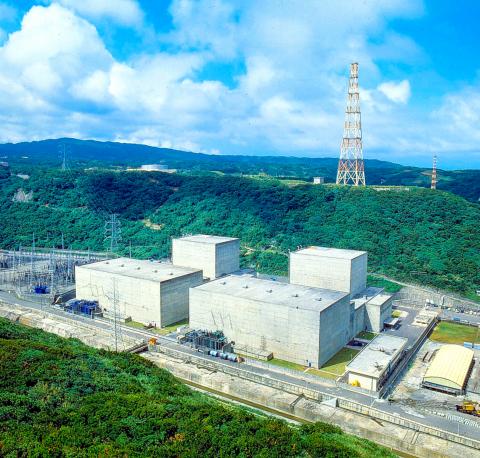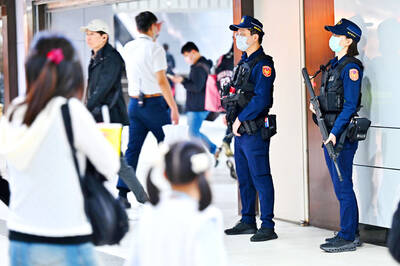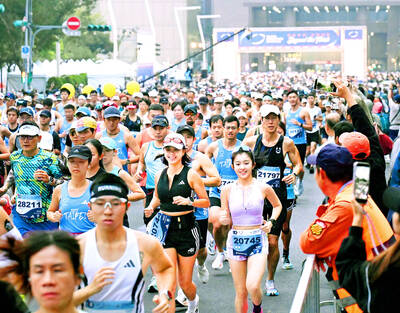Estimated annual expenditure at Taiwan Power Co’s (Taipower, 台電) Nuclear Power Back-end Operations Fund has surged by NT$100 billion (US$3.4 billion) due to plans to incorporate two separate expenditure items into the fund, the state utility said in its latest report to the Ministry of Economic Affairs.
The increased amount is due to changes in operational costs after the retirement of nuclear power plants and the merging of the Promoting the Development of Power and Energy Subsidies and Radioactive Waste Storage Compensatory funds into payout items for the operations fund.
Merging the expenditures was in response to requests made by local residents, State Enterprise Commission Vice Chairperson Wu Fong-sheng (吳豐盛) told a news conference after an inspection on Tuesday.

Photo courtesy of Taiwan Power Co
The residents demanded the continuation of payouts from the compensatory fund and subsidies based on rates when the power plant is running at full capacity, Wu said.
The company paid between NT$81 million and NT$85 million to residents of New Taipei City’s Shihmen (石門), Sanjih (三芝) and Jinshan (金山) districts in 2013 and 2014, when the Jinshan Nuclear Power Plant in Shihmen was running at full capacity.
The subsidies are based on the wattage of power generated, storage capacity and other necessities, Taipower said.
As for compensatory funds, the company offered NT$200 per barrel of low-radiation waste stored near the power plant and NT$60 per barrel for other areas, the company said.
The company offered NT$30,000 per tonne of waste for those living near the power plant and NT$9,000 per tonne in other areas.
Should the commission approve the request, the operation fund will pay NT$176 million per year, totaling NT$4.4 billion over 25 years, after which the power plant must shut down entirely, Wu said.
The commission would ask the company to consider offering a sum that would not be less than the subsidies offered when the plant is running at full capacity, Wu said.
As for changes in operational costs, Taipower cited additional expenditures of NT$30 billion to transform part of the plant into a dry storage facility, an undisclosed amount to establish a management center to centralize storage of nuclear waste, and another NT$20 billion for the eventual relocation of the Orchid Island (蘭嶼) storage facilities.
Depending on the storage site and method, it would cost NT$40 billion to NT$80 billion to store nuclear waste for the required 40 years, Taipower said.
The ministry told the Legislative Yuan that the total proposed expenditure of NT$470 billion is only one of the options being considered, adding that it would reach a final decision later.
The commission said that even if the budget proposal was approved, Taipower would still have to abide by the plans made by the ministry and the Atomic Energy Council, adding that the fund would be subject to re-evaluation every five years or during crises.
The fund is short NT$14 billion and if a proposal to raise the percentage of funds drawn from electricity fees is not approved by the Evaluation Committee for Power Pricing, Taipower would have to write the amount off as operational losses.
Starting from 1987, the public paid NT$0.14 to NT$0.18 to the fund per kilowatt of power generated, a figure that was increased to NT$0.17 in 2011 and to NT$0.37 in 2013, Taipower statistics showed.
As of December last year, the fund had accrued NT$338 billion, they showed.
The company said it estimates an annual expenditure of NT$20 billion until 2025 to cover the losses with operational surplus.

TRAGEDY STRIKES TAIPEI: The suspect died after falling off a building after he threw smoke grenades into Taipei Main Station and went on a killing spree in Zhongshan A 27-year-old suspect allegedly threw smoke grenades in Taipei Main Station and then proceeded to Zhongshan MRT Station in a random killing spree that resulted in the death of the suspect and two other civilians, and seven injured, including one in critical condition, as of press time last night. The suspect, identified as a man surnamed Chang Wen (張文), allegedly began the attack at Taipei Main Station, the Taipei Fire Department said, adding that it received a report at 5:24pm that smoke grenades had been thrown in the station. One man in his 50s was rushed to hospital after a cardiac arrest

PUBLIC SAFETY: The premier said that security would be tightened in transport hubs, while President Lai commended the public for their bravery The government is to deploy more police, including rapid response units, in crowded public areas to ensure a swift response to any threats, President William Lai (賴清德) said yesterday after a knife attack killed three people and injured 11 in Taipei the previous day. Lai made the remarks following a briefing by the National Police Agency on the progress of the investigation, saying that the attack underscored the importance of cooperation in public security between the central and local governments. The attack unfolded in the early evening on Friday around Taipei Main Station’s M7 exit and later near the Taipei MRT’s Zhongshan

SAFETY FIRST: Double the number of police were deployed at the Taipei Marathon, while other cities released plans to bolster public event safety Authorities across Taiwan have stepped up security measures ahead of Christmas and New Year events, following a knife and smoke bomb attack in Taipei on Friday that left four people dead and 11 injured. In a bid to prevent potential copycat incidents, police deployments have been expanded for large gatherings, transport hubs, and other crowded public spaces, according to official statements from police and city authorities. Taipei Mayor Chiang Wan-an (蔣萬安) said the city has “comprehensively raised security readiness” in crowded areas, increased police deployments with armed officers, and intensified patrols during weekends and nighttime hours. For large-scale events, security checkpoints and explosives

ON ALERT: Taiwan’s partners would issue warnings if China attempted to use Interpol to target Taiwanese, and the global body has mechanisms to prevent it, an official said China has stationed two to four people specializing in Taiwan affairs at its embassies in several democratic countries to monitor and harass Taiwanese, actions that the host nations would not tolerate, National Security Bureau (NSB) Director-General Tsai Ming-yen (蔡明彥) said yesterday. Tsai made the comments at a meeting of the legislature’s Foreign Affairs and National Defense Committee, which asked him and Minister of National Defense Wellington Koo (顧立雄) to report on potential conflicts in the Taiwan Strait and military preparedness. Democratic Progressive Party (DPP) Legislator Michelle Lin (林楚茵) expressed concern that Beijing has posted personnel from China’s Taiwan Affairs Office to its